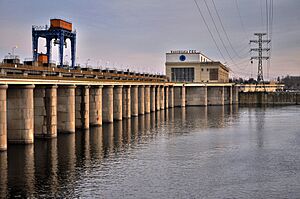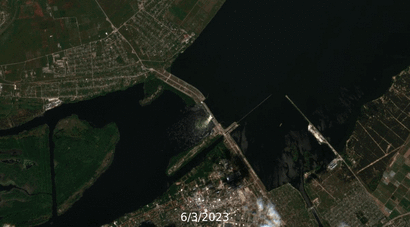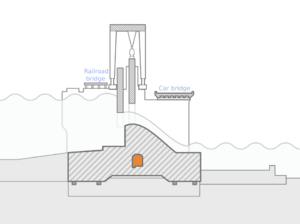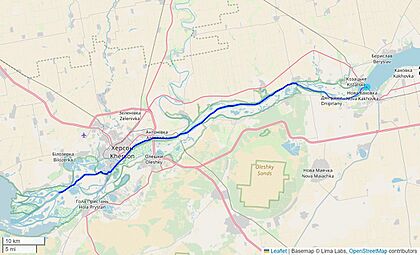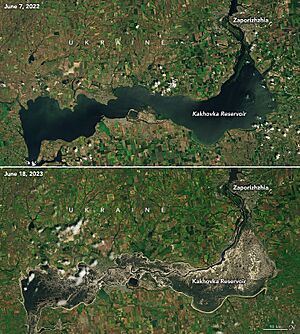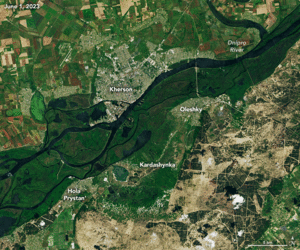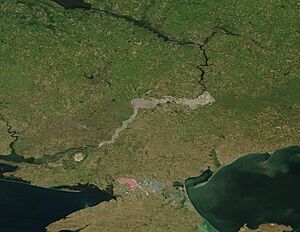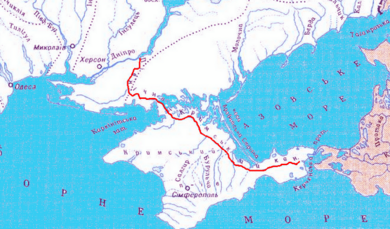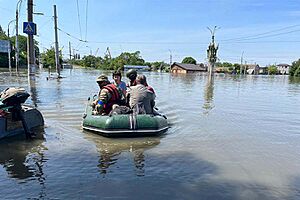Destruction of the Kakhovka Dam facts for kids
Quick facts for kids Destruction of the Kakhovka Dam |
|
|---|---|
| Part of the Dnieper campaign of the Russian invasion of Ukraine |
|
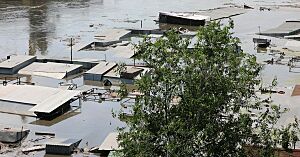
Flooding downstream from the dam
|
|
| Location | Kakhovka Hydroelectric Power Plant, Kherson Oblast, Ukraine |
| Coordinates | 46°46′40″N 33°22′13″E / 46.77778°N 33.37028°E |
| Date | 6 June 2023 between 02:00 and 02:54 (UTC+3) |
|
Attack type
|
Dam breaching |
| Weapons | Unknown |
| Deaths | 59 reported by Russian authorities Between 200 and 300 in Oleshky according to local health workers |
| Assailants | Disputed; Russia is blamed by most experts |
The Kakhovka Dam was seriously damaged in the early morning of June 6, 2023. This caused huge floods along the lower Dnieper River in Kherson Oblast, Ukraine. The dam was controlled by the Russian military, who had taken it over during the Russian invasion of Ukraine. Many experts believe Russian forces likely blew up part of the dam. They may have done this to slow down Ukraine's planned counter-offensive. Russian authorities have said they are not responsible.
The dam was about 30 meters (98 feet) tall and 3.2 kilometers (2 miles) long. The damaged part was about 85 meters (279 feet) long. Two days after the damage, the water level in the Kherson region was 5.61 meters (18.4 feet) higher than normal.
There were signs of an explosion when the dam was damaged. Both Ukrainian and Russian sources heard loud blasts from the dam's power station. Machines that detect ground movement (seismometers) also picked up explosion signals. A satellite even saw the heat from an explosion.
Water levels in the Kakhovka Reservoir, which Russia controlled, had been rising for months. They were at a 30-year high when the dam broke. Thousands of people living downstream had to leave their homes. Floods covered many villages in both Ukrainian and Russian-controlled areas. By June 21, 58 people were reported dead, and 31 were missing. Russian officials said 59 people drowned. However, health workers and a volunteer grave digger from Oleshky said hundreds died in that city alone. They said reporting deaths was difficult due to interference. The floods killed many animals and damaged farms, homes, and roads. The loss of water from the reservoir could affect water supply to Russian-controlled Crimea and the Zaporizhzhia Nuclear Power Plant. But there was no immediate danger to either.
Contents
Understanding the Kakhovka Dam's History
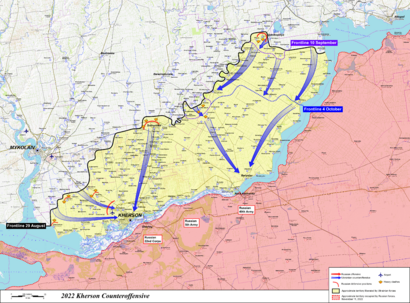
The Kakhovka Dam made the Dnieper River 16 meters (52 feet) deeper. This created the Kakhovka Reservoir. It was Ukraine's second-largest reservoir by area and the biggest by water volume.
Another dam on the Dnieper was damaged twice during World War II in Ukraine. In 1941, the Soviet Union blew up the Dnieper dam to stop the German army. This killed many civilians and soldiers. In 1943, German troops blew it up again as they retreated.
The Kakhovka dam was built in 1956. Russian forces took control of it in February 2022. This was early in the Russian invasion of Ukraine. Russia also attacked other Ukrainian buildings, damaging dams and cutting off water. Examples include attacks on the Kyiv dam, the Oskil river dam, and the Kryvyi Rih dam.
Ukrainian military intelligence said Russian forces placed "major mining" explosives at the Kakhovka dam in February 2022. In April 2022, they mined locks and supports. They also put "tented trucks with explosives" on the dam itself. In October 2022, Ukraine's president, Volodymyr Zelenskyy, warned that Russia might destroy the Kakhovka dam and blame Ukraine. He asked for international observers at the dam.
On October 19, 2022, the Institute for the Study of War (ISW) said Russia was likely preparing a false-flag attack on the dam. This means Russia would damage the dam and then blame Ukraine. They might use the floods to cover their own retreat.
In late 2022, Ukraine took back the western bank of the Dnieper during the Kherson counteroffensive. Ukraine accused Russia of planning to blow up the Kakhovka dam in return. During this time, a Ukrainian general thought about flooding the Dnieper River below the dam. So, Ukrainian forces tested HIMARS rockets on one of the dam's floodgates. The test worked, and this action was kept as a "last resort."
When Russian forces left Kherson in November 2022, they destroyed the bridge deck behind them. This damaged some of the sluice gates.
The Russians then opened more sluice gates. This let water rush out of the reservoir. Ukraine believed Russia wanted to flood the area south of the dam. This would stop Ukrainian forces from crossing the Dnieper River. Ukraine's hydro electric company also thought Russian forces opened the locks because they feared Ukrainian soldiers advancing. Spring 2023 had a lot of rain, 3.5 times the normal amount in April.
From mid-February to late May 2023, the damaged dam was not adjusted for the increased water flow. This might have been on purpose or due to neglect. As a result, water flowed over the top of the dam, and land upstream flooded. Water levels in the reservoir reached a 30-year high. Some think Russia might have let water levels rise to make the collapse more impactful.
A small part of a wall between the dam and the power plant broke on April 23. This was 44 days before the dam failed.
On May 28, a satellite photo showed a car on top of the dam. It seemed to be loaded with explosives like barrels and a land mine. A Ukrainian official said the car was meant to stop any Ukrainian attack. It also would make any Russian explosion from the machine room stronger. Early drone videos suggest the dam's destruction started near the machine room.
On May 30, 2023, less than a week before the dam broke, the Russian government made a new rule. It said that until 2028, no investigations would happen for accidents at dangerous sites in occupied Ukraine. This included accidents from military actions or sabotage. An adviser to Ukraine's president called this a "smoking gun." He said it was too much of a coincidence.
On June 2, a small part of the road over the dam collapsed. Parts of the supports also broke, according to satellite images. An NPR science reporter said this showed "structural issues" before the main event.
The Institute for the Study of War reported on June 6 that Russian sources were very worried. They thought Ukraine might be preparing to cross the river and attack.
How the Dam Was Destroyed
Between 2:18 and 2:20 AM local time on June 6, 2023, loud sounds like explosions were heard from the Kakhovka Hydroelectric Power Plant. People in Nova Kakhovka discussed the explosions online. One resident described "orange flares" and said the water was "very noisy" at 2:45 AM. Ukrainian President Volodymyr Zelenskyy said there was an "internal explosion" at 2:50 AM. The explosions were so strong that they shook windows 80 kilometers (50 miles) away.
Seismometers in Romania and Ukraine, far from the dam, detected signals. Scientists from Norwegian Seismic Array (NORSAR) thought these signals meant an explosion. A weak signal was detected at 2:35 AM, and a stronger one at 2:54 AM.
NORSAR experts said the 2:54 AM signal looked like an explosion. But they were not sure how powerful it was. They said it was a man-made event, but it's still unclear if it caused the dam to collapse.
United States spy satellites detected a heat signal at the dam just before it collapsed. This signal was like what a big explosion would make.
Experts told The New York Times on June 7 that an explosion from inside the dam was the most likely cause. They said an attack from outside, like a missile, would not have enough force. Also, a natural structural failure was less likely.
Ihor Syrota, head of Ukraine's hydroelectric power company Ukrhydroenergo, said shelling or a natural collapse was Russian propaganda. He stated, "The plant was designed to withstand a nuclear strike. To destroy the plant from the outside, at least three aircraft bombs, each of 500 kg, would have had to [have been] dropped on the same spot. The station was blown up from the inside."
Christopher Binnie, a dam engineer, said that two breaks on either side of a structure mean natural causes are very unlikely. He also said it was unlikely Ukrainian shelling caused it. To destroy the dam, "massive explosives" would need to be placed close to its base.
The New York Times looked into the dam failure again on June 16. They spoke with Ihor Strelets, an engineer who worked at the dam. He said most of the dam's huge concrete structure was hidden underwater. This concrete block, 20 meters (66 feet) high and up to 40 meters (131 feet) thick, held back the water. It also meant the dam, built during the Cold War, could survive almost any outside attack. The sluice gates were on top of this concrete. After the dam broke, it was clear that not only the gates but also the concrete foundation were destroyed. There had been earlier damage to the road over the dam and some gates. A small part of a concrete wall also collapsed on April 23. Experts said this could be a sign of erosion.
However, dam experts told the NYT that this earlier damage or high water pressure would not have been enough to destroy the dam's foundation. There was a tunnel inside the foundation. Experts said this would be the perfect place to put explosives strong enough to blow up such a structure. Evidence suggests this is where they were placed. Nick Glumac, an explosives expert, said, "It's hard for me to see how anything other than an internal explosion in the passageway could account for the damage. ... That's a massive amount of concrete to move."
The New York Times also spoke with Ben Dando, a seismologist. He said the two seismic signals detected at 2:35 AM and 2:54 AM fit with a deep explosion inside the dam. This kind of explosion would be strong enough to break the huge structure. They do not fit with a dam collapsing naturally. Engineers agreed, based on the satellite heat signal. Volker Oye, another seismologist, said, "We see a pulse of energy which is focused, which is typical of an explosion." He said a blast like this not from an explosion would be a strange coincidence. After the first blast, videos show water further tearing the dam apart. Engineers said this kind of damage to such a huge concrete foundation is very unlikely without a deep explosion. They said a full examination of the foundations is needed for a final answer.
The Conflict Intelligence Team (CIT) believes the dam collapsed due to structural problems caused by Russian neglect. They say that the gates being open on one side for eight months caused erosion in the soil under the dam. This weakened its stability. CIT says that if this is true, Russia is still fully to blame.
CIT also questioned the NYT's analysis. They asked why erosion in one spot couldn't lead to wider dam erosion. They also asked why the NYT didn't explain the gradual collapse of the road before the dam broke. CIT also wondered how the 2:54 AM seismic event could be from an explosion that destroyed the dam. Local residents reported explosions around 2:20 AM, and a video showed the dam already destroyed at 2:46 AM.
Mark Mulligan, a geography professor, said structural failure from earlier war damage is still possible. He said the very high water level and previous damage could have led to a huge structural failure.
Andrew Barr, an expert in blast damage, said the dam had three parts:
- A central concrete section with gates (a barrage).
- A hydroelectric power plant (HPP).
- A long, earth-filled embankment dam.
Early videos show the barrage went first, likely from explosives. Barr believes the damage to the barrage is too much for guided missiles. He thinks the HPP went next, which could only happen from an explosion under the turbine hall. This explosion would be separate from the barrage explosion. Last, a part of the earth-filled embankment broke. Barr said the huge amount of water quickly washed away the soil.
Who Is Responsible for the Dam's Destruction?
The Euroactiv media network says "most experts agree a Russian attack is the more likely" reason. Experts told The New York Times that "the evidence clearly suggests the dam was crippled by an explosion set off by the side that controls it: Russia." A report by Global Rights Compliance (GRC) said Russia caused the destruction with "pre-emplaced explosives." They said this was "highly likely," meaning 80% or more certain.
The Institute for the Study of War (ISW) agreed, saying "the preponderance of available evidence... suggests that Russian forces deliberately damaged the dam." ISW believes Russia had a "greater and clearer interest" in flooding the Dnieper. This would make it harder for Ukraine to cross, even if it flooded some Russian positions. Other groups also concluded Russia destroyed the dam.
The Conflict Intelligence Team thinks the dam collapsed due to Russian negligence. They say Russia is still responsible because of this.
Ukrainian authorities agree with international experts. They say Russian forces destroyed the dam with an explosion inside the engine room. Ukrainian officials said Russia destroyed the dam "in a panic" to slow down Ukraine's planned counteroffensive. Ukraine specifically blamed Russia's 205th Separate Motor Rifle Brigade. Journalists reported intercepted calls involving members of this brigade. The calls mention preparing to do something "all on command" and an "emergency event." The brigade's online channel had warned in October 2022 that the dam was mined. On June 9, Ukraine's Security Service released what they said was an intercepted call. In it, alleged Russian officers admit responsibility, saying the explosion was meant to "scare" people but they "did more than what they planned for."
The European Parliament said on June 15, 2023, that Russia's destruction of the Kakhovka dam was a war crime. A senior American military official said the U.S. government believes the explosion came from charges set inside the dam, most likely by Russian agents.
Russian government officials first said the dam was fine. Later, they denied responsibility and blamed Ukraine.
Impacts of the Dam's Destruction
Casualties and Evacuations
At least 59 people died from the dam's destruction, according to Russian authorities. Ukraine's Interior Minister reported 31 deaths.
The Associated Press reported in December 2023 that Russian authorities purposely undercounted deaths. They quickly removed bodies and stopped health workers from helping. Ukrainian health workers believe hundreds died, but the exact number may never be known.

Satellite images clearly show how much flooding happened.
The day after the dam broke, Ukraine's prosecutor general thought about 40,000 people would be affected. This included people in both Ukrainian and Russian-controlled areas. The Ukrainian governor of Kherson Oblast said about 600 square kilometers (230 square miles) of the region were underwater. He noted that 68 percent of the flooded land was on the Russian-controlled side.
The flooding along the Dnieper also caused water to flow backward into the Inhulets River. This led to flooding in Kherson and Mykolaiv Oblast.
The National Police of Ukraine ordered evacuations on the Ukrainian-controlled western bank of the Dnieper. This included several villages and parts of Kherson city. The governor of Kherson Oblast said eight villages were flooded. He reported that 16,000 residents were being evacuated by bus and train.
Ukrainian ground forces said the Russian army kept shelling the right bank during the evacuation. On June 7, President Volodymyr Zelenskyy claimed Russian forces were killing rescuers. Three people died after Russian forces shot at an evacuation boat on June 12.
In Russian-controlled Nova Kakhovka, 22,000 people live in flood risk areas. Six hundred houses were reported flooded. Russian authorities declared a state of emergency on the left bank. On June 6, Russian officials listed 14 towns at risk of flooding.
Ukrainian authorities said 17,000 people were being evacuated from Ukrainian-controlled areas. Twenty-four villages were flooded.
The Ukrainian Environment Ministry reported on June 25 that the Dnipro River had returned to its normal banks.
Animals and Environment
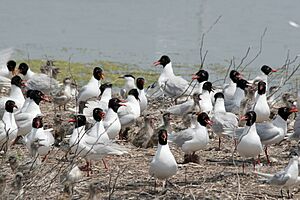
Many wildlife habitats were flooded. About 300 animals at the Fairytale Dibrova Zoo drowned. The zoo was just downstream from the dam. The Red Cross warned that minefields were washed away. An official said, "We knew where the hazards were ... Now we don't know. All we know is that they are somewhere downstream."
Former ecology minister Ostap Semerak called this the biggest environmental disaster in Ukraine since the 1986 Chernobyl disaster.
The Ukrainian Nature Conservation Group reported on the environmental damage. Andriy Yermak, head of the Office of the President of Ukraine, said on June 20 that over 50,000 hectares (123,550 acres) of Ukrainian forests were flooded. At least half of these trees will die. He also said the Kakhovka Reservoir was covered with 95,000 tons of dead fish.
The Great Meadow National Nature Park was completely drained. This raised fears of a drought. Water levels also dropped by about 13 meters (43 feet) in the Kamianska Sich National Park.
Chemicals like ammonia and bacteria like Salmonella and Escherichia coli entered the water. This led to beach closures and fishing bans in Odesa and Mykolaiv Oblasts. Authorities said these areas became "garbage dumps" and "animal cemeteries." Ukraine claimed that cholera outbreaks happened in Russian-occupied areas.
Ecologist Alexey Vasilyuk said industrial waste, including heavy metals, had settled at the bottom of the Kakhovka Reservoir. Now, the river current is stirring this waste into the water. The dried-out areas will also have metals blown away by the wind. These metals can be absorbed by plants that people and animals eat.
A year after the dam's destruction, wildlife returned to the area. Fish like sturgeon and herring came back. Willow and poplar trees also started to grow.
Military Impact
The flooding was expected to make it harder for the Ukrainian army to cross the Dnieper River. Vladimir Saldo, the Russian-installed governor of occupied Kherson, said the damage would help Russian forces defend the area. He said it was "operationally and tactically in favour of Russian forces."
Many experts noted that the dam's destruction removed a road crossing. Only the Antonivsky Bridge in Kherson city remained as a paved river crossing. Former Ukraine defense minister Andrii Zahorodniuk said it makes crossing the river "impossible."
Analysts also said floodwaters would make the soil swampy for weeks. This would prevent heavy machinery like tanks from moving. The increased difficulty of moving forces would help secure Russia's southern flank. This would free up troops to fight Ukraine's offensive in Zaporizhzhia Oblast.
Also, the emergency would use up resources Ukraine could have used for the war.
Five days after the dam broke, Ukrainian Deputy Defense Minister Hanna Malyar said Russia was moving its best forces from Kherson to Bakhmut. She said Russia likely destroyed the dam to shorten its defense lines in Kherson. But four days later, the Institute for the Study of War had not seen Russian troops move.
The UK Defense Ministry said on June 19 that Russia had moved troops from the Dnieper River's eastern bank. These troops went to strengthen areas in Zaporizhzhia and Bakhmut. This likely means Russia thinks a major Ukrainian attack across the Dnieper is less likely.
Retired U.S. general David Petraeus said on June 6 that the damage would not have "military implications that are particularly large." He said the flooded area would clear up over time. He also said that as flood waters go down, the river might become shallower and easier to cross. He believes this event will not stop Ukraine.
Before the dam broke, the Kakhovka Reservoir was 5–20 kilometers (3–12 miles) wide. This made it hard for an army to cross. As of June 20, satellite images show it has returned to a river 500–1000 meters (1,640–3,280 feet) wide. The flood plain on either side is drying quickly. In some places, it might be possible to cross the Dnieper River in a 4WD vehicle. Some think Ukraine could use this, especially since Russia has moved troops away. Ukraine also controls dams upstream and could dry up the river further.
On November 15, Russia admitted Ukrainian forces had crossed the Dnieper river. But they claimed the Ukrainian attack would fail.
Water Supply Challenges
Water from the dam reservoir supplied Southern Ukraine, Crimea, and the Zaporizhzhia Nuclear Power Plant. As floods affected water pipes, President Zelenskyy said hundreds of thousands of people lacked "normal access to drinking water." Residents were told to boil water. The United Nations later estimated about 700,000 people needed clean drinking water. Over a million people in Dnipropetrovsk Oblast alone might face water shortages.
The Zaporizhzhia Nuclear Power Plant needs a minimum water level of 12.7 meters (41.7 feet) in the Kakhovka Reservoir for cooling. However, there are other ways to get cooling water while the reactors are shut down. The International Atomic Energy Agency said there was "no immediate risk to the safety of the plant."
The head of Ukraine's hydropower company said the water level dropped below the "dead" point of 12.7 meters (41.7 feet). This means water could no longer be taken for towns or the nuclear plant. How low it would go depended on how much of the dam was destroyed. If the base was gone, the water level could reach about 3 meters (9.8 feet). The reservoir's width would shrink from 3.5 kilometers (2.2 miles) to 1-1.2 kilometers (0.6-0.7 miles). Initially, the water level fell 0.35 meters (1.1 feet) per hour. After 24 hours, it fell 2.5 meters (8.2 feet) at Nikopol. After 48 hours, it was 13.05 meters (42.8 feet). On June 26, Ukrhydroenergo said the Kakhovka Reservoir became "catastrophically" shallow. The average depth was 7-8 meters (23-26 feet) and could go to 3 meters (9.8 feet). The Dnipro River at Kherson returned to its pre-dam level.
Oleksandr Kubrakov, Ukraine's Minister of Infrastructure, announced on July 3 that Ukraine began building three pipelines. These pipelines, almost 150 kilometers (93 miles) long, will supply drinking water to over 1 million people. This includes people in Zaporizhzhia, Kherson, Mykolayiv, and Dnipropetrovsk regions. Funds were set aside for this project.
Ukrhydroenergo is also planning to build an "overlay" across the dam site. This would restore water levels. This project would start after Russian forces leave the east side of the Dnieper. It is expected to take two months. However, the Russian-installed governor of Kherson said Russia would do any restoration work. This would only happen after Ukrainian troops are pushed back.
On June 21, satellite images showed the reservoir had dried up a lot. It revealed the original path of the Dnipro River. Four canal networks were cut off. By June 20, the reservoir's water surface area was less than a quarter of its former size.
New wells are being dug for local water needs. After the reservoir drained, the groundwater level dropped greatly. Before, wells reached water at 38 meters (125 feet). By September, they had to drill 60-70 meters (197-230 feet). The village of Malokaterynivka lost its water supply and now gets water by truck.
North Crimean Canal
|
North Crimean Canal Intake
|
|---|
The North Crimean Canal is over 400 kilometers (249 miles) long. It usually supplied 85% of Crimea's water. Most of this water was used for farming. After Russia took over Crimea in 2014, Ukraine blocked the canal. This stopped water flow for eight years. It was unblocked in March 2022 after Russians took control of Kherson Oblast. Farmland shrank, and some crops could not be grown.
The canal starts at Tavriisk, just upstream from the destroyed dam. The Russian-installed mayor of Nova Kakhovka said the dam's destruction would cause "problems" with water supplies to Crimea. Russian officials said it was a "calculated Ukrainian attempt to choke off water supplies" to Crimea. However, the Crimean occupation authority said there was "no threat" to the canal's water.
On June 10, 2023, the Institute for the Study of War saw a Russian video showing the North Crimean Canal was dry. This went against Russian statements. Ukrainians accused Russians of not having a clear plan to solve the problem.
Ihor Syrota, head of Ukraine's hydro electric company, said on June 12, 2023, that water would not flow to Crimea through the canal "for at least a year." This is because the Kakhovka Reservoir's water level is much lower than the canal's intake.
Christopher Binnie, a water engineer, said pumping for water supply to Crimea could restart soon. Sergey Aksyonov, head of the Russian-annexed Republic of Crimea, said pumps on the Dnieper River could supply water to the canal.
Farming and Fisheries
The area irrigated by the Kakhovka Reservoir usually gets little rain in summer. This means crops need irrigation to grow well. Before the dam, most of Kherson and Zaporizhzhia were dry. The Ukrainian Ministry of Agriculture said the dam's destruction will leave 584,000 hectares (1.4 million acres) of land without irrigation. This will turn them into "deserts." In 2021, this land produced about 4 million tons of grains and oilseeds. This was about 4% of Ukraine's total. Most irrigation systems in Kherson, Zaporizhzhia, and Dnipro regions will be without water.
Oleksandr Krasnolutskyi, Ukraine's deputy environment minister, said floodwater washed away topsoil from thousands of farms. He said, "We will not be able to cultivate agricultural plants on this soil for many years ahead."
Ukraine is not in danger of famine. Before the war, Ukraine produced more grain than it needed. However, the dam disaster will lower Ukraine's farming income. It could also lead to food shortages in world markets.
The Ukrainian government announced financial help for farmers affected by the dam.
On July 13, 2023, Mykola Solskyi, Ukraine's Minister of Agrarian Policy and Food, said 11,400 tons of fish were lost. This was worth about US$267 million. He said 85 fisheries were destroyed. The Kakhovka Reservoir was home to at least 43 fish species. It could take 7–10 years to bring back the lost fish.
Energy and Reconstruction Costs
The Kakhovka Hydroelectric Power Plant's destruction means a loss of 350 MW of power. This is enough to power 350,000 homes.
In March 2023, before the dam was destroyed, a report estimated Ukraine's reconstruction cost at US$411 billion. This could go over US$1 trillion depending on the war.
Ivan Perehinets, from Ukraine's Academy of Construction, said it would cost US$60–70 billion to rebuild homes and infrastructure in Kherson Oblast. This would take 5–10 years and 1.5 million workers.
Ruslan Strilets, Ukraine's Environment Minister, said the dam's destruction caused an initial US$1.5 billion in damage. He also warned that Russian mines released by flooding could float to other European countries. Ukraine's Agriculture Ministry estimated damage to water systems at US$4.1–4.3 billion. The Kyiv School of Economics estimated direct losses at US$2 billion. The United Nations later estimated total damage at about $14 billion.
The idea of using Russian frozen assets to pay for these costs is being discussed. But institutions like the European Central Bank worry about financial stability.
Ukraine's Ministry of Reintegration reported on August 23 that the government set aside funds for reconstruction. This included money for damaged homes. Ukraine also started a program to pay residents for destroyed homes.
Legal Actions and Responses
Former Deputy Prosecutor General of Ukraine Gyunduz Mamedov said Ukraine should ask the Secretary General of the UN for help. This is because the dam's destruction might violate the Environmental Modification Convention. He also said a case should go to the International Court of Justice for compensation.
Greenpeace legal advisor Daniel Simons said a trial could happen in the International Criminal Court (ICC). This would happen if there is enough evidence. He said attacking the environment that causes lasting damage could be a war crime. ICC investigators are already looking into damage in Ukraine. Russia, the United States, and China do not follow the ICC. The ICC has already issued an arrest warrant for Russian president Vladimir Putin. This is for illegally moving children from occupied Ukraine.
Both Russia and Ukraine have asked the ICC and the International Court of Justice to blame the other side.
Western leaders called the dam's destruction a war crime. Article 56 of Protocol I to the Geneva Conventions says it is forbidden to destroy "installations containing dangerous forces" like dams. Both Russia and Ukraine have agreed to these rules.
Ukrainian Reactions
Ukrainian President Volodymyr Zelenskyy said the dam's destruction "confirms for the whole world that they must be expelled from every corner of Ukrainian land." Andriy Yermak, Head of the Office of the President of Ukraine, called it "ecocide" (destroying the environment). The Ukrainian Ministry of Foreign Affairs asked the international community to condemn the attack. They called for a UNSC session and a meeting with the IAEA. Ukraine's Prosecutor General is investigating it as a war crime.
Ukrainian foreign minister Dmytro Kuleba criticized international media. He said they made Ukrainian and Russian claims seem equally true. He argued this put "facts and propaganda on [an] equal footing."
Former Ukrainian Minister of Ecology Ostap Semerak said this would affect Romania, Georgia, Turkey, and Bulgaria. He called it the worst environmental disaster in Ukraine since Chornobyl in 1986.
Russian Reactions
Russian authorities blamed Ukraine. Russian president Vladimir Putin called it "a barbaric act which has led to a large-scale environmental and humanitarian catastrophe." Kremlin spokesman Dmitry Peskov called it "sabotage" by Ukrainian forces. Minister of Defence Sergey Shoigu said Ukraine blew up the dam to "prevent Russian offensive." Vladimir Saldo, the Russian-installed governor of occupied Kherson, said the dam damage "is operationally and tactically in favour of Russian forces." Russian news reported that flooding made a Ukrainian crossing impossible. Russian Foreign Ministry spokeswoman Maria Zakharova said the event needed a "worldwide study." She accused the West of always blaming Russia. On June 13, Putin again said the dam's destruction "thwarted Ukrainian offensive." He also suggested past HIMARS strikes were responsible.
International Reactions
António Guterres, the UN Secretary-General, called the collapse "another devastating consequence of the Russian invasion of Ukraine." He said attacks on civilians and infrastructure must stop. NATO Secretary General Jens Stoltenberg called it "outrageous" and showed Russia's "brutality." European Council President Charles Michel called it a war crime. The Council of Europe strongly condemned the destruction.
President of Romania Klaus Iohannis condemned the dam's destruction as "another war crime by Russia." He called for Russia to be held accountable. Moldovan President Maia Sandu and Prime Minister Dorin Recean also condemned it. German Chancellor Olaf Scholz said "this is aggression by the Russian side to stop the Ukrainian offensive." The Czech Republic's Ministry of Foreign Affairs said Russia's actions "deliberately endangering the lives of tens of thousands" of civilians. British Prime Minister Rishi Sunak said it was too early to say Russia was responsible. But British Foreign Secretary James Cleverly said the issue exists "because of Russia's unprovoked full-scale invasion." France's Emmanuel Macron called it an "atrocious act." France also sent aid like water purifiers. The German Marshall Fund said Russia launched an "aggressive" propaganda campaign to blame Ukraine.
China's UN representative, Zhang Jun, asked all sides to follow international law. Turkish President Recep Tayyip Erdoğan suggested an international commission to investigate. This commission would include experts from both sides, the UN, and Turkey. Ukrainian Foreign Minister Dmytro Kuleba did not like this idea. He said past UN missions for similar events did not work.
The UN said on June 18 that Russia refused its requests to access occupied areas for humanitarian aid. The UN urged Russia to follow international humanitarian law. A defense analyst said Russia might refuse because it doesn't want outside eyes. Also, Russia might be using the flooding as a defense.
Aftermath and Future Plans
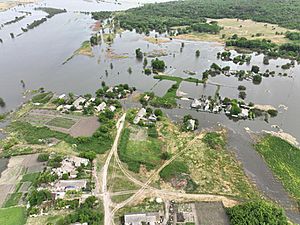
On June 6, a Ukrainian colonel said Russian forces blew up private ponds near villages in occupied Zaporizhzhia Oblast. This was to stop a Ukrainian counteroffensive. Flooding was also reported in other villages. Intentional flooding was reported in the former Yakymivka Raion and around Tokmak.
On June 7, Ihor Syrota, head of Ukrhydroenergo, said it would take "at least 5 years [and] US$1 billion" to rebuild the dam. On June 15, he added another year would be needed for other work, making it six years total.
On July 18, Ukrainian Prime Minister Denys Shmyhal announced a two-stage plan to rebuild the Hydroelectric Power Plant. The first stage is designing and preparing. The second stage is actual construction, starting after Russian forces leave. This two-year estimate is much shorter than the previous six years.
A study in August 2023 suggested a temporary dam could be built in one year. This would refill the reservoir to at least 12.7 meters (41.7 feet). This would provide water but no hydropower or shipping. A permanent dam and power plant could be built at the same time. The study also suggested the new power plant should be larger.
It has been reported that Rostec, a Russian state-owned company, plans to build 9 seawater desalination plants in Crimea by 2030. These plants would produce about 1 billion cubic meters of freshwater per year. This is the amount of water that flowed to Crimea before 2014. However, these plants would need half the power used by Crimea.
On June 8, President Volodymyr Zelenskyy visited flooded areas in Kherson Oblast. Reports on the same day said Russia was shelling Kherson as evacuations continued.
On June 11, Ukrainian media claimed Russian forces demolished a smaller dam near Kliuchove on the Mokri Yaly river. This was to slow down Ukrainian advances.
On June 13, a Ukrainian military official reported that Russian forces had placed mines at many small dams in Zaporizhzhia and Kherson. They were destroying some daily to disrupt Ukrainian operations.
On June 12, Ukrainian intelligence claimed Russia was mining workshops at the Crimean Titan chemical factory in Armiansk. An explosion there was feared to cause a major disaster.
On June 7, Turkish President Recep Tayyip Erdoğan suggested an international commission to investigate the dam's destruction. Ukrainian Foreign Minister Dmytro Kuleba did not like this idea. He said past UN missions for similar events, like the Olenivka killings, did not work.
The UN announced on June 18 that Russia refused its requests to access occupied areas for humanitarian aid. The UN urged Russia to follow international humanitarian law.
See also
- International sanctions during the Russian invasion of Ukraine
- Attacks on civilians in the Russian invasion of Ukraine
- Impact of the Russian invasion of Ukraine on nuclear power plants
- Deliberate Soviet dam destruction in Ukraine during World War II
- Scorched earth
- 2022 Irpin river Kozarovychi dam opening, flooding Demydiv
Similar international events:
- 1914 inundation on the Yser in Flanders during World War I
- 1938 Yellow River flood, a similar human-made wartime river flood
- 1943 Operation Chastise, Allied attack on German dams during World War II
- 1945 Dutch floods during World War II
- 1952 attack on the Sui-ho Dam
- 2014 Battle for Mosul Dam, during the War in Iraq (2013–2017)
- Itaipu Dam, caused concern that in times of conflict could be used as a weapon to flood Buenos Aires
- Proposed bombing of Vietnam's dikes
General:
- List of hydroelectric power station failures


